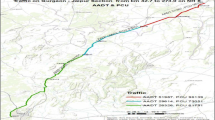Abstract
Road accidents have emerged as a major public health problem globally. The scope of road accident data usage is limited to serve statistical purposes. Therefore it is necessary to identify high-frequency accident locations by performing risk evaluation using Geographic Information System (GIS) and statistical analysis to enhance road safety. GIS is a powerful spatial analytics system for accident pattern analysis. Our aim is to provide a cloud based GIS application for Roorkee City that visualizes the analysis of hotspots in raster as well as vector format using kernel density estimation, buffer analysis and nearest neighborhood analysis for accident and hospital locations over the cloud to achieve shortest path from accident locations to nearest hospitals and police stations. The accident locations have been classified into five zones i.e. very high accident frequency zone, accident frequency zone, moderate accident frequency zone, less accident frequency zone and very less accident frequency zone using heat map analysis with the help of kernel density estimation. Quantum-GIS have been applied for heatmap analysis, buffer analysis and nearest neighborhood analysis over the cloud. Periodically the database will get updates and reduce accident severity. Any user can get any information about road accident attributes with coordinates, date and time over the cloud and will be of benefit for decision-making processes.






Similar content being viewed by others
References
NHAI. (2017). http://nhai.org.in/ last viewed in 4th October 2017.
Deshpande, P. (2014). Road safety and accident prevention in India: a review. International Journal of Advanced Engineering Technology, 5(2), 64–68.
Nagarajan, M., & Mathew, C. (2009). Identification of Black spots and accident analysis on NH 45 using Remote Sensing and GIS. International Journal of Civil Engineering, 1(1), 49–56.
Lizamol, I., Shibu, A., & Saran, M. S. (2013). Evaluation and treatment of accident black spots using Geographic Information System. International Journal of Innovative Research in Science Engineering and Technology, 2(8), 3866–3873.
Pulugurtha, S. S., Krishnakumar, V. K., & Nambisan, S. S. (2007). New methods to identify and rank high pedestrian crash zones: An illustration. Accident Analysis and Prevention, 39(4), 800–811.
Khan, M. A., Sarwar, M., & Sajjad Khan, M. M. (2004). Feeding value of urea treated corn cobs ensiled with or without enzose (corn dextrose) for lactating crossbred cows. Asian-Australasian Journal of Animal Sciences, 17(8), 1093–1097.
Liang, L. Y., Ma’soem, D. M., & Hua, L. T. (2005). Traffic accident application using geographic information system. Journal of the Eastern Asia Society for Transportation Studies, 6, 3574–3589.
Anderson, T. K. (2009). Kernel density estimation and K-means clustering to profile road accident hotspots. Accident Analysis and Prevention, 41(3), 359–364.
Zhang, Q., Cheng, L., & Boutaba, R. (2010). A cloud computing: state-of-the-art and research challenges. Journal of internet services and applications, 1(1), 7–18.
Evangelidis, K., Ntouros, K., Makridis, S., & Papatheodorou, C. (2014). Geospatial services in the a cloud. Computers & Geosciences, 63, 116–122.
Bhat, M. A., Shah, R. M., & Ahmad, B. (2011). A cloud computing: A solution to Geographical Information Systems (GIS). International Journal of Computer Science and Engineering, 3(2), 594–600.
Okabe, A., & Sugihara, K. (2012). Spatial analysis along networks: statistical and computational methods. New York: Wiley.
Erdogan, S., Yilmaz, I., Baybura, T., & Gullu, M. (2008). Geographical information systems aided traffic accident analysis system case study: City of Afyonkarahisar. Accident Analysis and Prevention, 40(1), 174–181.
Larsen, M. (2010). Philadelphia traffic accident cluster analysis using GIS and SANET. Master of Urban Spatial Analytics, School of Design, University of Pennsylvania.
Yamada, I., & Thill, J. C. (2004). Comparison of planar and network K-functions in traffic accident analysis. Journal of Transport Geography, 12(2), 149–158.
Kim, K., Brunner, I. M., & Yamashita, E. (2008). Modeling fault among accident—involved pedestrians and motorists in Hawaii. Accident Analysis and Prevention, 40(6), 2043–2049.
Zovak, G., Brcic, D., & Saric, Z. (2014). Analysis of road black spots identification method in the Republic of Croatia. In IX International Conference Road Safety in Local Communities.
Mustakim, F., & Fujita, M. (2011). Development of accident predictive model for the rural roadway. World Academy of Science, Engineering, and Technology, 58(2011), 126–131.
Abbasi, S. A., & Arya, D. S. (2000). Environmental impact assessment: Available techniques, emerging trends. New Delhi: Discovery Publishing House.
Brodeur, J. (2016). Carto 2016 Workshop-Introduction to Open Source GIS with QGIS.
Kam, B. H. (2003). A disaggregate approach to crash rate analysis. Accident Analysis and Prevention, 35(5), 693–709.
Oyedepo, O. J., & Makinde, O. (2010). Accident prediction models for Akure–Ondo carriageway, Ondo State Southwest Nigeria; using multiple linear regressions. African Research Review, 4(2), 30–49.
Acknowledgements
This work was supported by the Ministry of Human Resource Development [Grant Number MHR-02- 23-200- 429]. I would also like to thank Miss Azeb Kebebew for her support during data collection and research paper preparation.
Author information
Authors and Affiliations
Corresponding author
Electronic supplementary material
Below is the link to the electronic supplementary material.
Rights and permissions
About this article
Cite this article
Pritee, K., Garg, R.D. Cloud based spatial visualization with statistical approach for road accidents. Spat. Inf. Res. 25, 825–835 (2017). https://doi.org/10.1007/s41324-017-0148-9
Received:
Revised:
Accepted:
Published:
Issue Date:
DOI: https://doi.org/10.1007/s41324-017-0148-9




